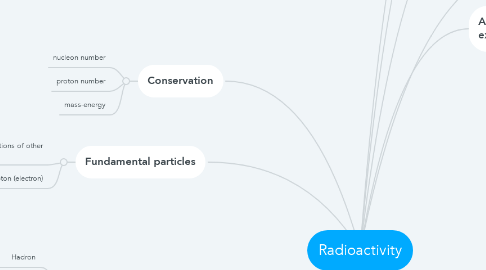
1. Conservation
1.1. nucleon number
1.2. proton number
1.3. mass-energy
2. Fundamental particles
2.1. not consist of combinations of other particles
2.2. e.g. lepton (electron)
3. Weak interaction between quarks
3.1. The role of it in the transmutation of quarks makes it the interaction involved in many decays of nuclear particles which require a change of quark from one flavor to another. Neutrino interaction induces beta decay.
4. Matter and antimatter
4.1. If a particle collides with its antiparticles, they annihilate each other, producing photons.
5. Subatomic particles
5.1. Hadron
5.1.1. composed of quarks, particles affected by strong nucleus force, subject to strong and weak force, bulky
5.1.1.1. meson: 2 quarks -> quark and antiquark
5.1.1.2. baryon: 3 quarks
5.1.1.2.1. proton: baryon number: +1
5.1.1.2.2. neutron: baryon number: +1
5.2. Leptons
5.2.1. particles that are unaffected by strong nuclear force, subject to weak force, light
5.2.1.1. neutrinos
5.2.1.2. electron
5.2.1.3. muon
5.2.1.4. tau
5.2.2. charge: -1
5.2.3. fundamental particle
6. quark
6.1. + 2/3 e
6.1.1. up, u
6.1.2. charm, c
6.1.3. top, t
6.2. - 1/3 e
6.2.1. down, d
6.2.2. strange, s
6.2.3. bottom, b
7. For reaction to occur
7.1. they must have same charge, baryon number (B) and electron lepton number (Le)
8. Alpha particle scattering experiment--Rutherford
8.1. 1. most alpha particles go through foil in straight line.
8.1.1. most of the atom is empty space
8.2. 2. some alpha particles were deviated with angles less then 90 degree.
8.2.1. nucleus takes positive charge
8.3. 3. only a few alpha particles were deviated with large angles greater than 90 degess.
8.3.1. mass and charge of atom concentrated in a small volume
9. Simple model of nuclear atom
9.1. proton and neutron in the nucleus and electron around the nucleus
10. Isotopes
10.1. Atoms of the same element that have same proton number but different number of neutron.
11. Representation of nuclides
11.1. Nuclides: special combinations of protons and neutrons
12. Radiation
12.1. Total number of nucleons remains constant as does the total number of mass of the nucleus is converted to energy of the emitted radiation--mass-energy conservation
12.1.1. Alpha
12.1.1.1. Helium nucleus contains 2 protons and 2 neutrons
12.1.1.2. strong ionising power, but short range, only can travel few cm in the air
12.1.1.3. positively charged
12.1.1.4. daughter particle has less mass than original particle before emitting radiation --> mass lost has been converted into energy as the source of kinetic energy of alpha particle. the total mass-energy is conserved.
12.1.1.5. a few cm in the air, stopped by a few sheets of paper
12.1.1.6. equations
12.1.2. Beta
12.1.2.1. Beta-
12.1.2.1.1. neutron in the nucleus changes into a proton and a high energy electron which is emitted
12.1.2.1.2. mass number stays the same, proton number increases by 1
12.1.2.1.3. A very light, electrically-neutral antiparticle called antineutrino is also emitted. conservation of electric charge required this particle to be electrically neutral
12.1.2.1.4. equations
12.1.2.2. Beta+
12.1.2.2.1. when a proton decays into a neutron and a high energy positron and electron neutrino.
12.1.2.2.2. mass number stays the same, proton number decrease by 1
12.1.2.2.3. equations
12.1.2.3. around 1 m in the air, stopped by several mm of aluminium
12.1.3. Gamma
12.1.3.1. high energy electromagnetic radiation
12.1.3.2. nucleus changes shape into a more stable shape, gamma radiation (gamma ray) emitted as a result
12.1.3.3. gamma decay can occur alongside alpha and beta decay, when an unstable nucleus adjusts to a more stable energy level.
12.1.3.3.1. mass-energy is conserved in nuclear reaction, energy might be released by gamma rays when sum of the masses on the left-hand side of the equation is not the same as right-hand side.
12.1.3.4. not affected by electric and magnetic fields
12.1.3.5. unlimited range in air, stopped by several cm of lead
12.1.3.6. equations

